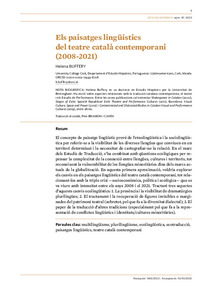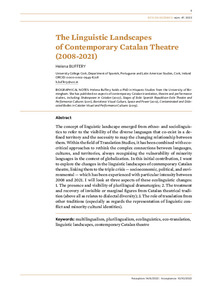| dc.contributor.author | Buffery, Helena | |
| dc.date.accessioned | 2022-12-31T12:59:42Z | |
| dc.date.available | 2022-12-31T12:59:42Z | |
| dc.date.issued | 2022 | |
| dc.identifier.issn | 2385-362X | |
| dc.identifier.issn | 0212-3819 | |
| dc.identifier.uri | http://hdl.handle.net/20.500.11904/1510 | |
| dc.description.abstract | <p>El concepte de paisatge lingüístic prové de l’etnolingüística i la sociolingüística per referir-se a la visibilitat de les diverses llengües que conviuen en un territori determinat i la necessitat de cartografiar-ne la relació. En el marc dels Estudis de Traducció, s’ha combinat amb qüestions ecològiques per repensar la complexitat de la connexió entre llengües, cultures i territoris, tot reconeixent la vulnerabilitat de les llengües minoritàries dins dels marcs actuals de la globalització. En aquesta primera aproximació, voldria explorar els canvis en els paisatges lingüístics del teatre català contemporani, tot relacionant-los amb la triple crisi —socioeconòmica, política i ecològica— que es va viure amb intensitat entre els anys 2008 i el 2021. Tractaré tres aspectes d’aquests canvis ecolingüístics: 1. La presència i la visibilitat de dramatúrgies plurilingües; 2. El tractament i la recuperació de figures invisibles o marginades del patrimoni teatral (sobretot, pel que fa a la diversitat dialectal); 3. El paper de la traducció d’altres tradicions (especialment pel que fa a la representació de conflictes lingüístics i identitats/cultures minoritàries).</p> | |
| dc.description.abstract | <p>The concept of linguistic landscape emerged from ethno- and sociolinguistics to refer to the visibility of the diverse languages that co-exist in a defined territory and the necessity to map the changing relationship between them. Within the field of Translation Studies, it has been combined with eco-critical approaches to rethink the complex connections between languages,<br />cultures, and territories, always recognising the vulnerability of minority languages in the context of globalization. In this initial contribution, I want to explore the changes in the linguistic landscapes of contemporary Catalan theatre, linking them to the triple crisis — socioeconomic, political, and environmental — which has been experienced with particular intensity between 2008 and 2021. I will look at three aspects of these ecolinguistic changes: 1. The presence and visibility of plurilingual dramaturgies; 2. The treatment and recovery of invisible or marginal figures from Catalan theatrical tradition (above all as relates to dialectal diversity); 3. The role of translation from other traditions (especially as regards the representation of linguistic conflict and minority cultural identities).</p> | |
| dc.relation.ispartof | Estudis escènics: quaderns de l'Institut del Teatre. 2022, Núm. 47 | |
| dc.title | Els paisatges lingüístics del teatre català contemporani (2008-2021) | |
| dc.type | Article | |
| dc.date.updated | 2022-12-31T12:59:43Z | |
| dc.rights.access | Open Access | |



